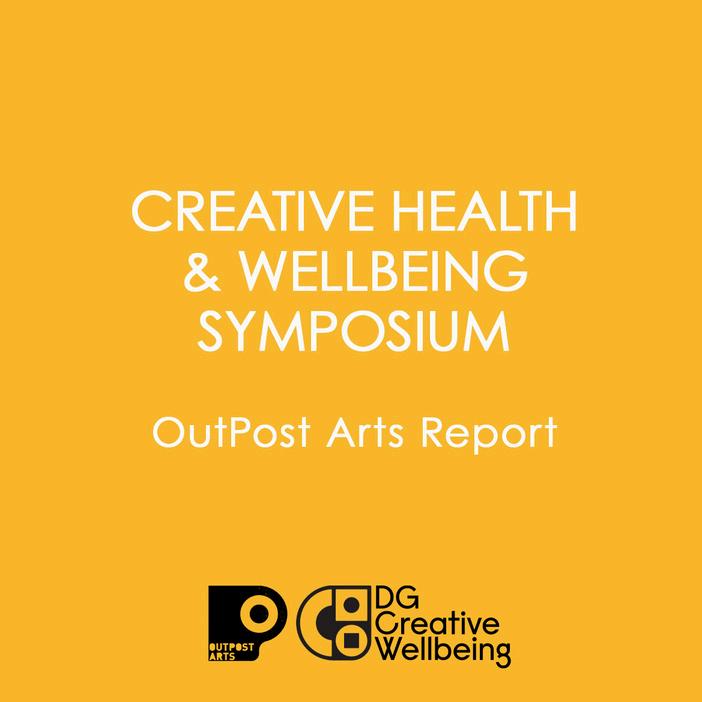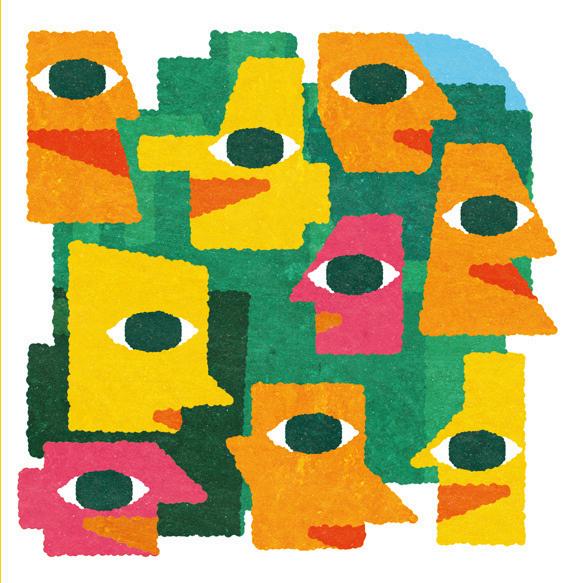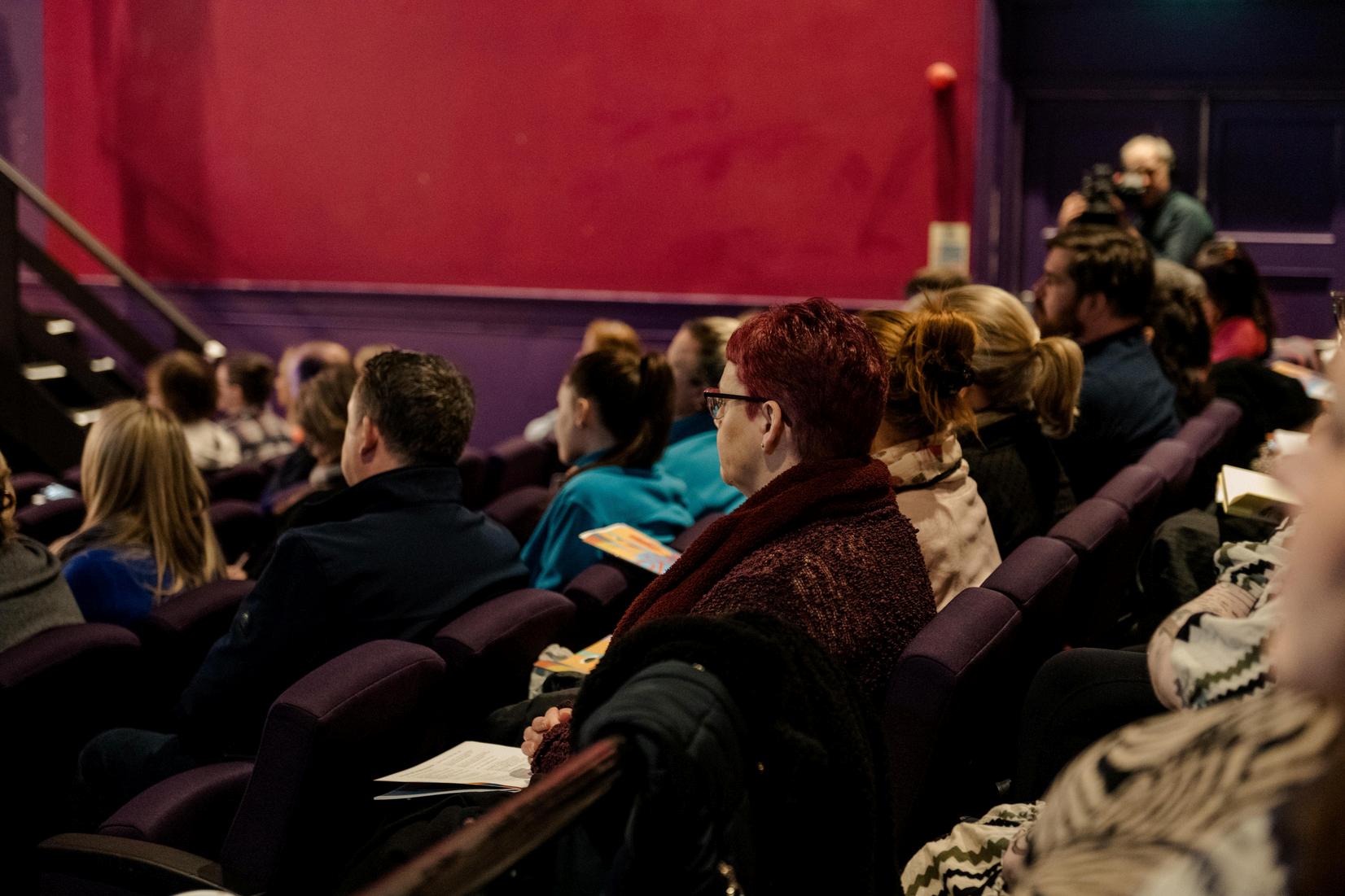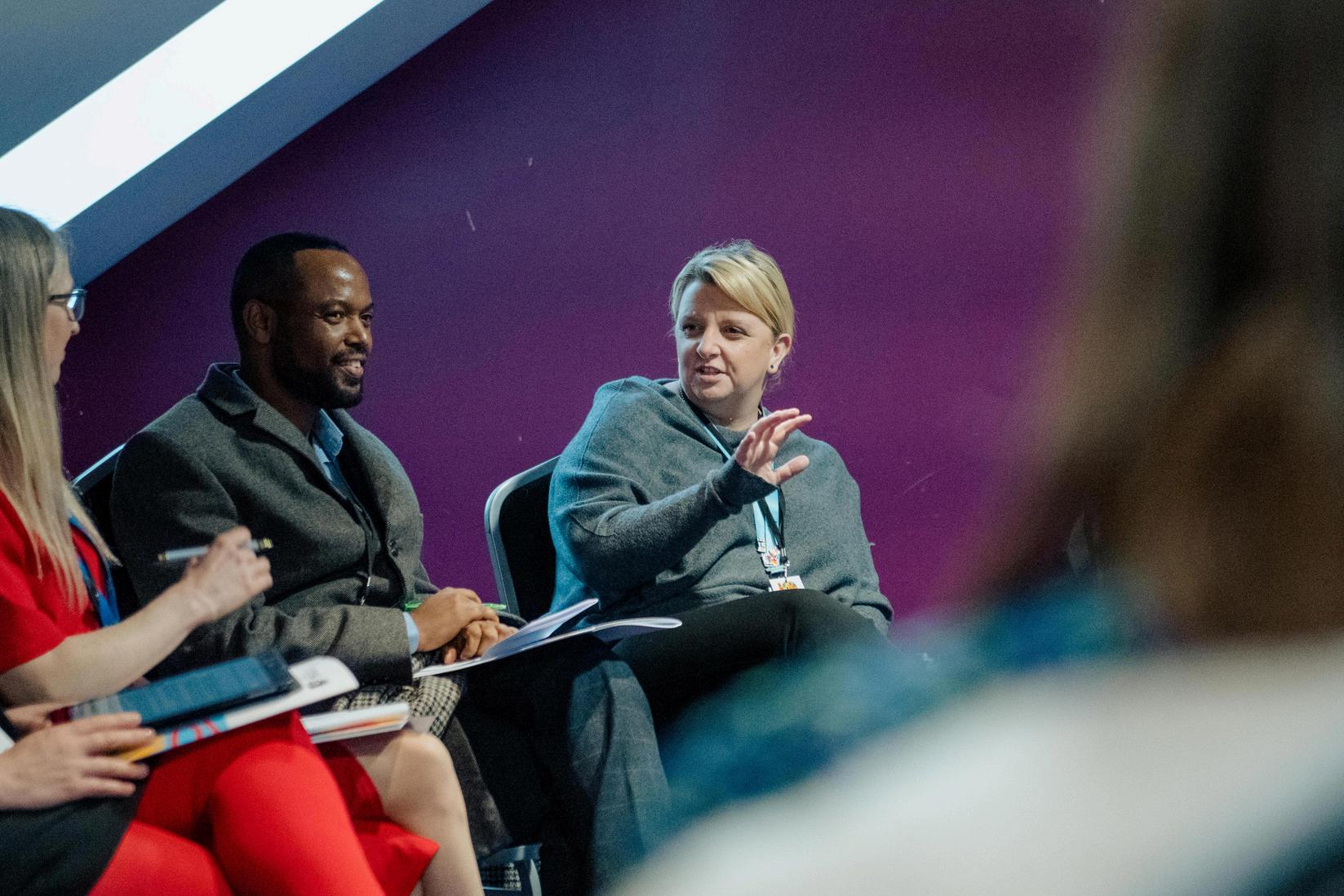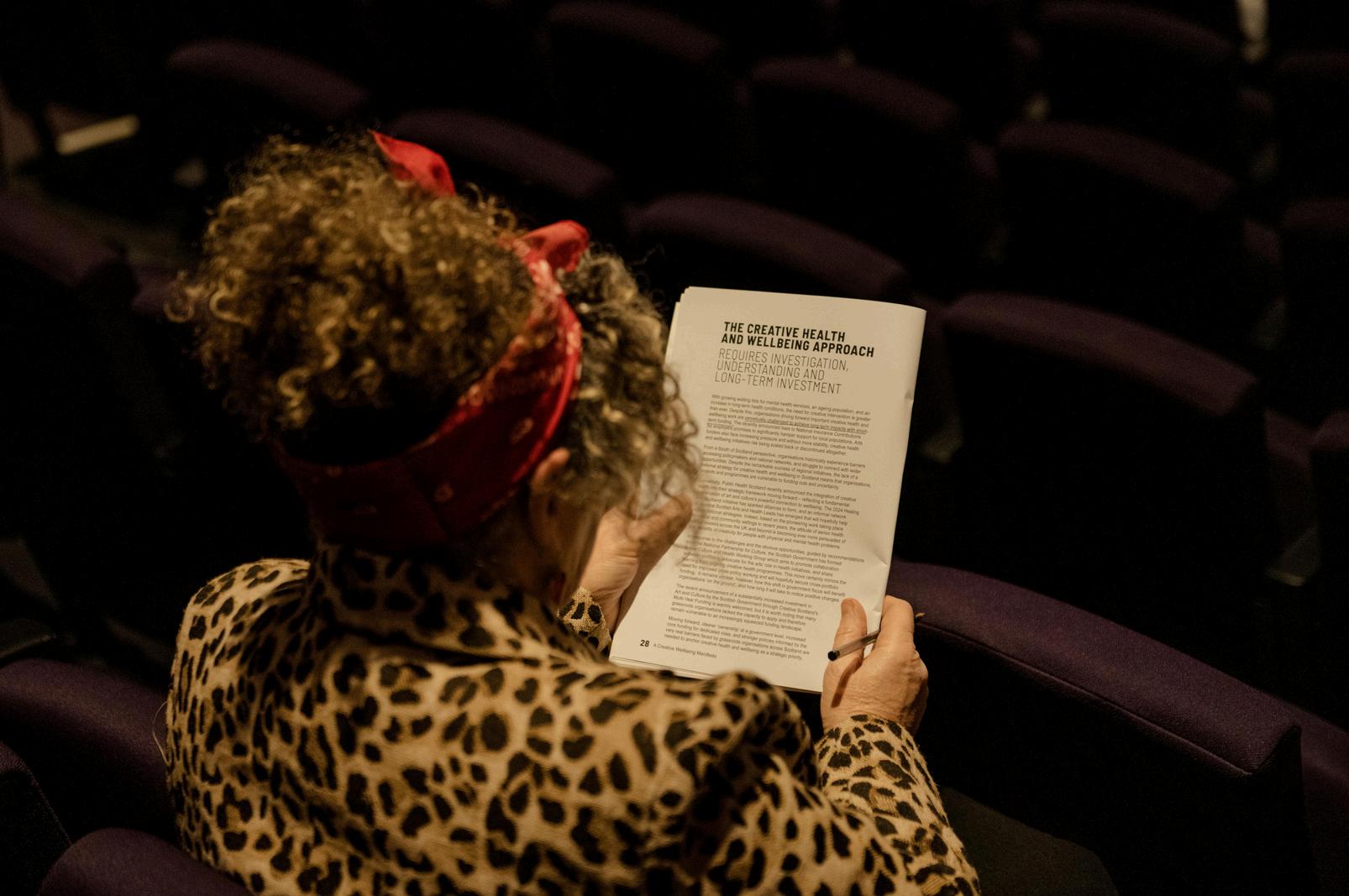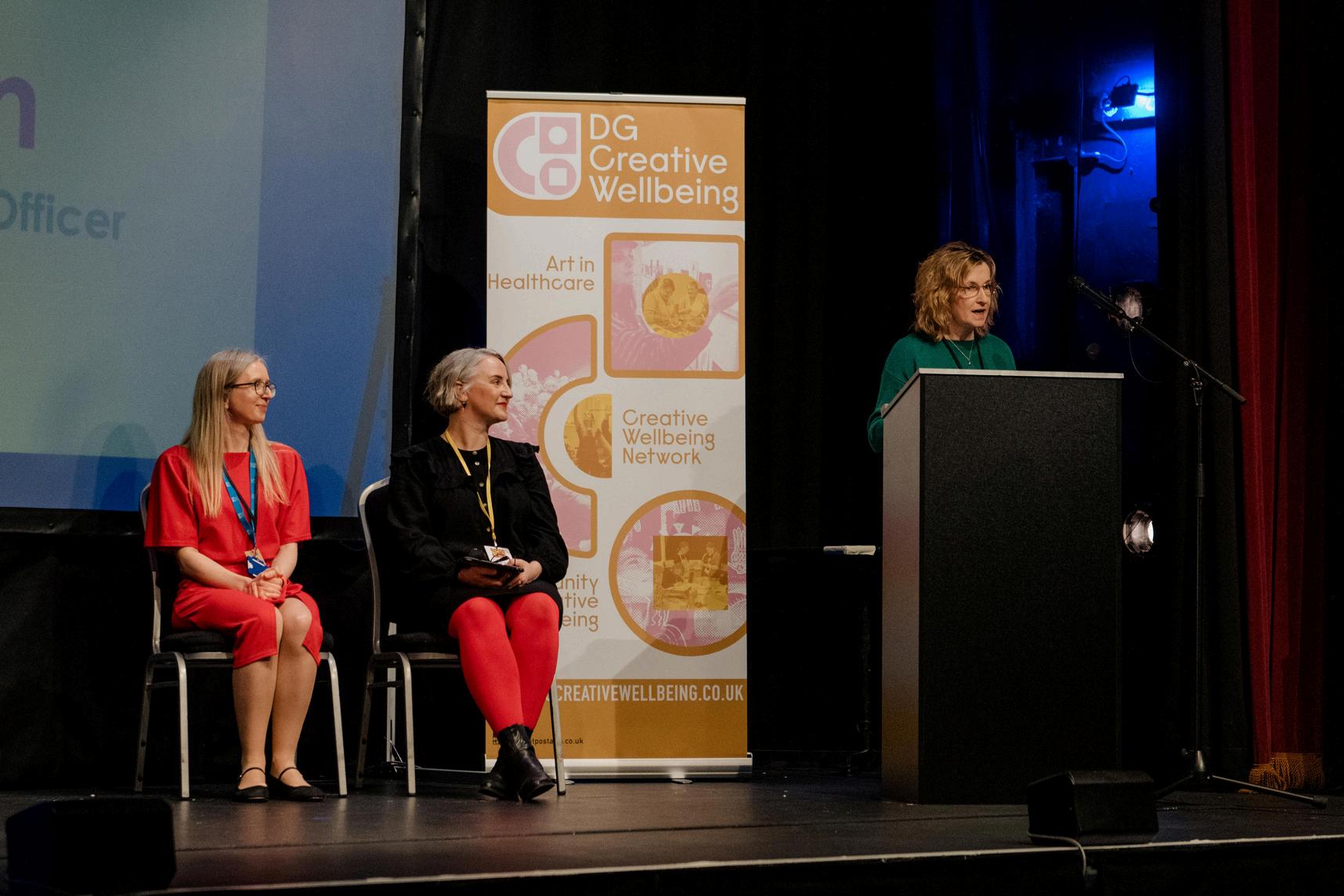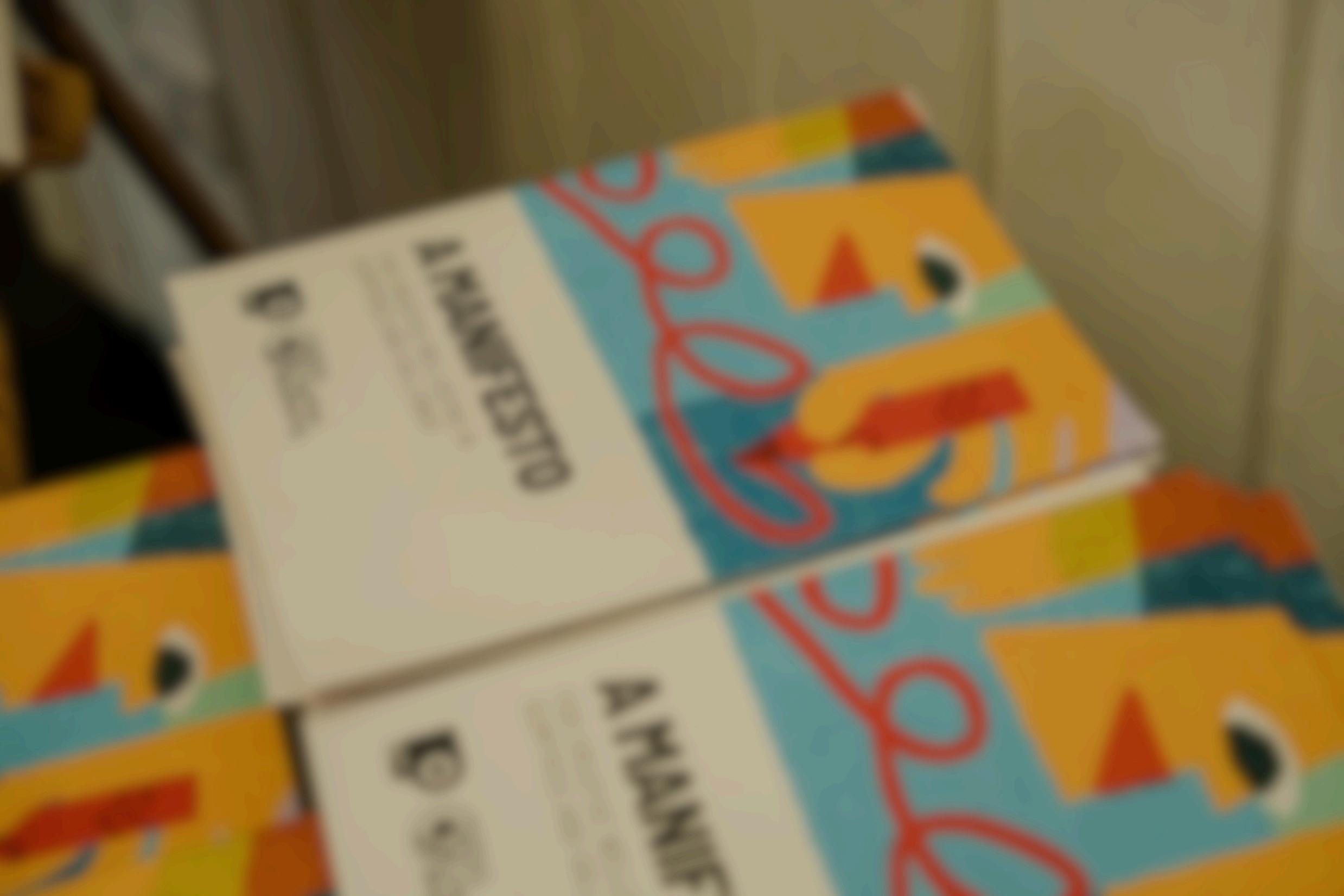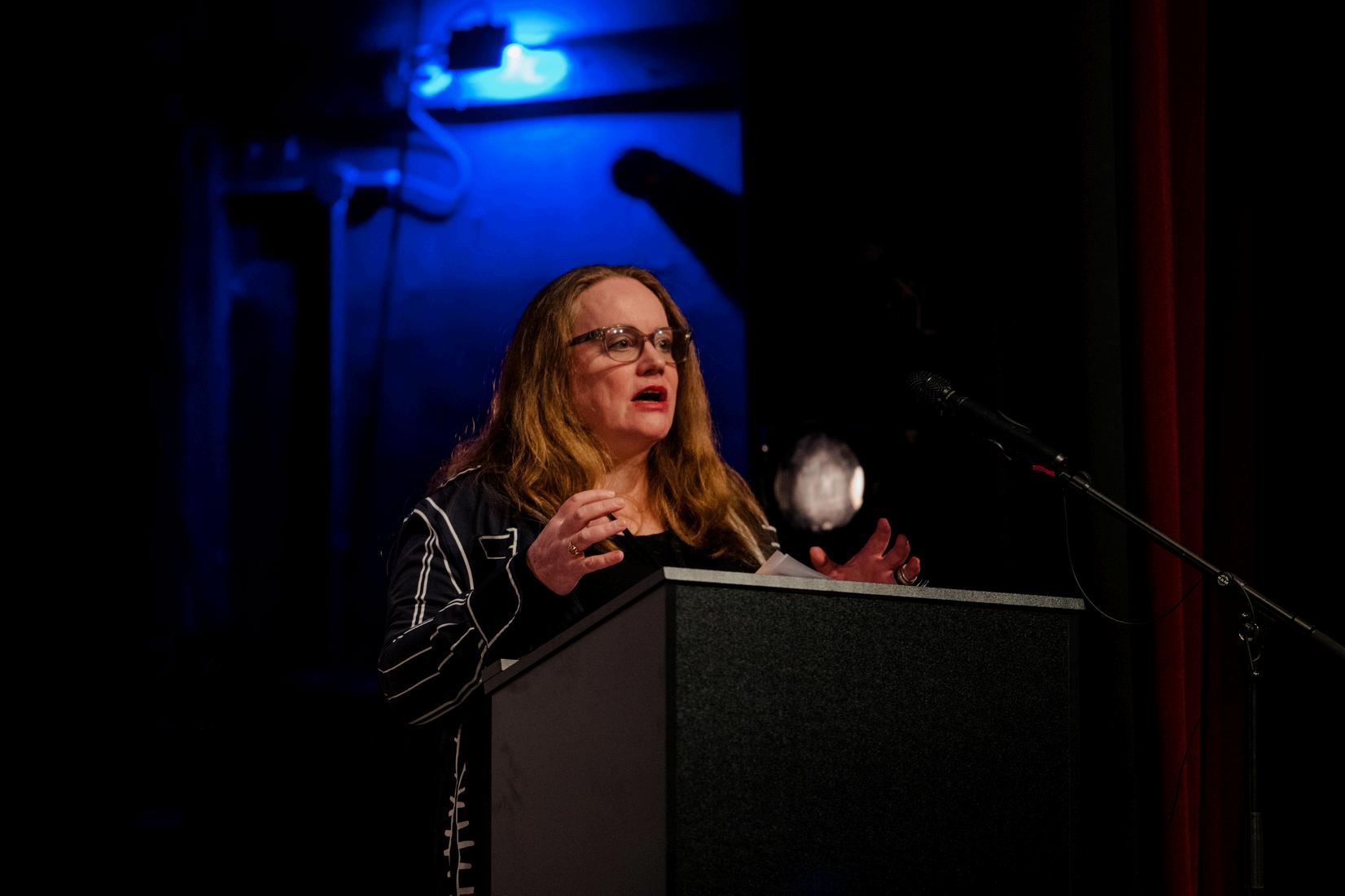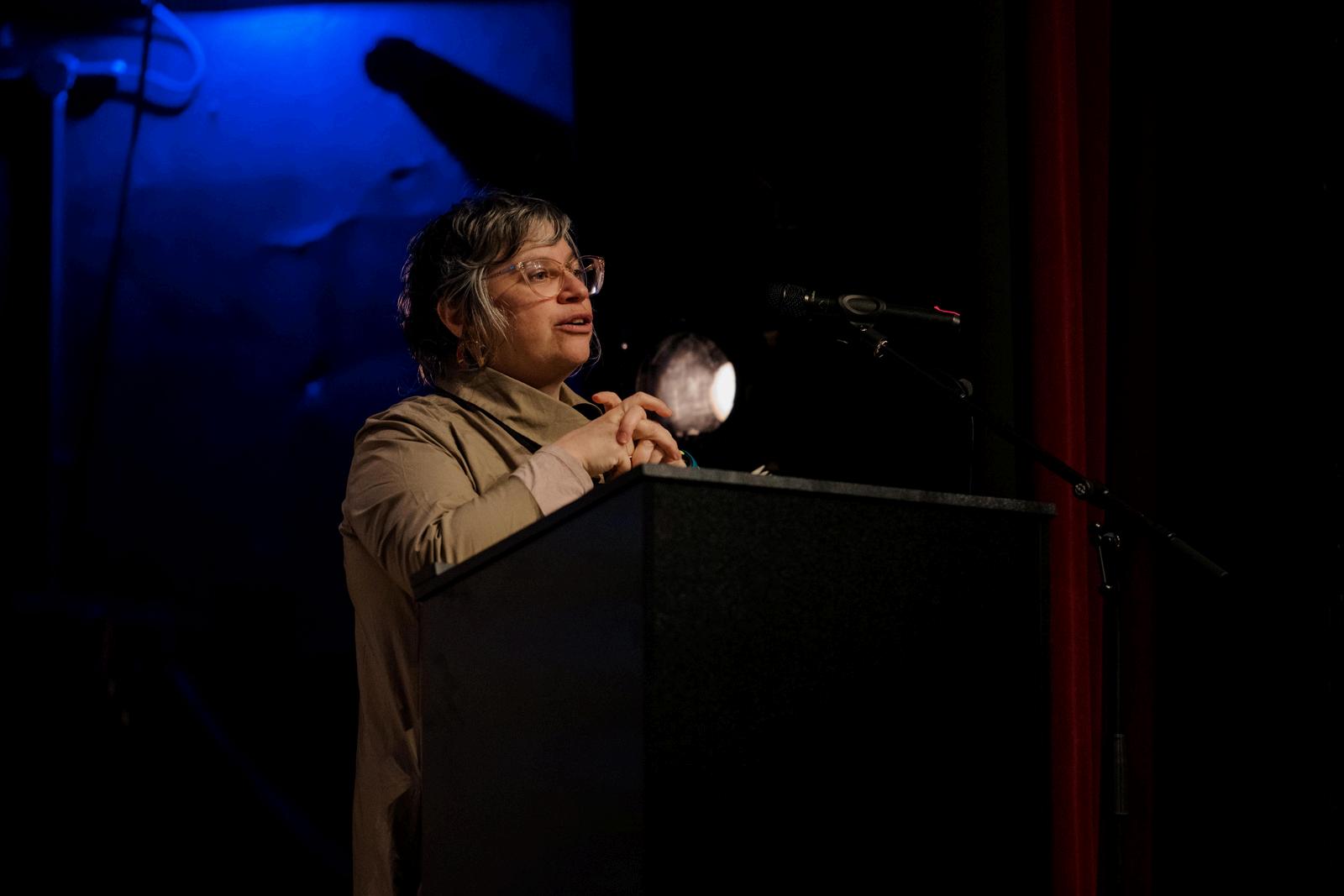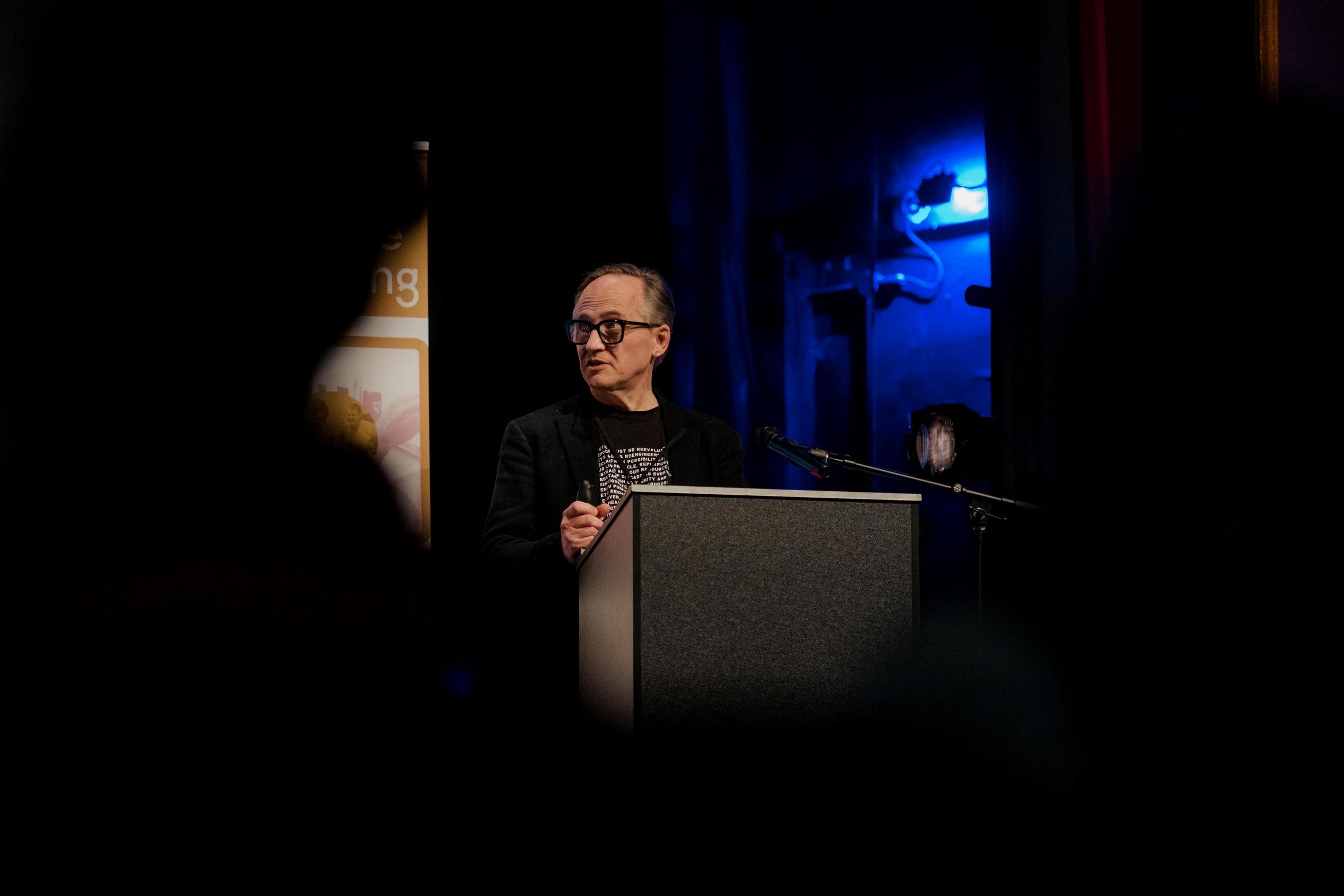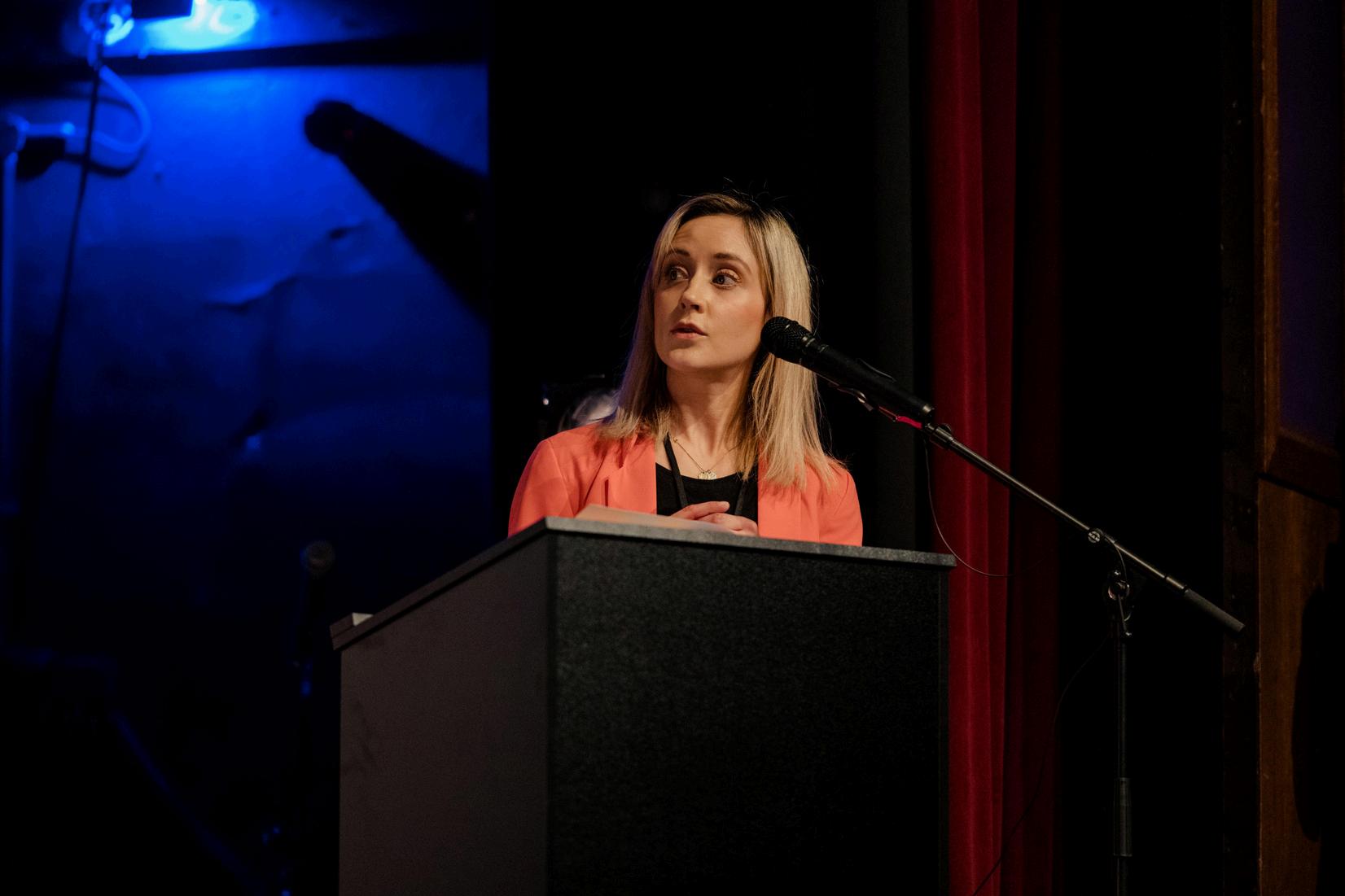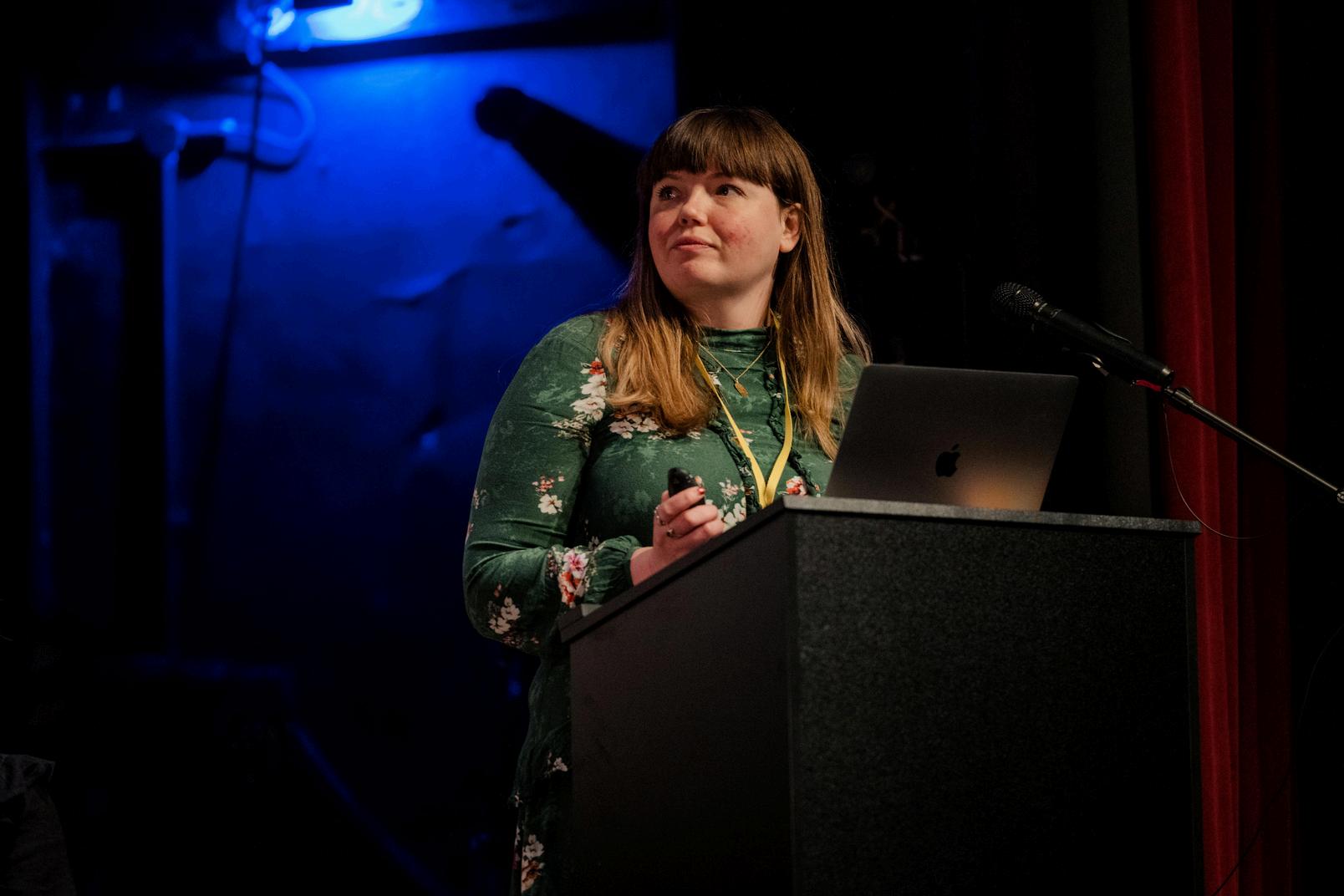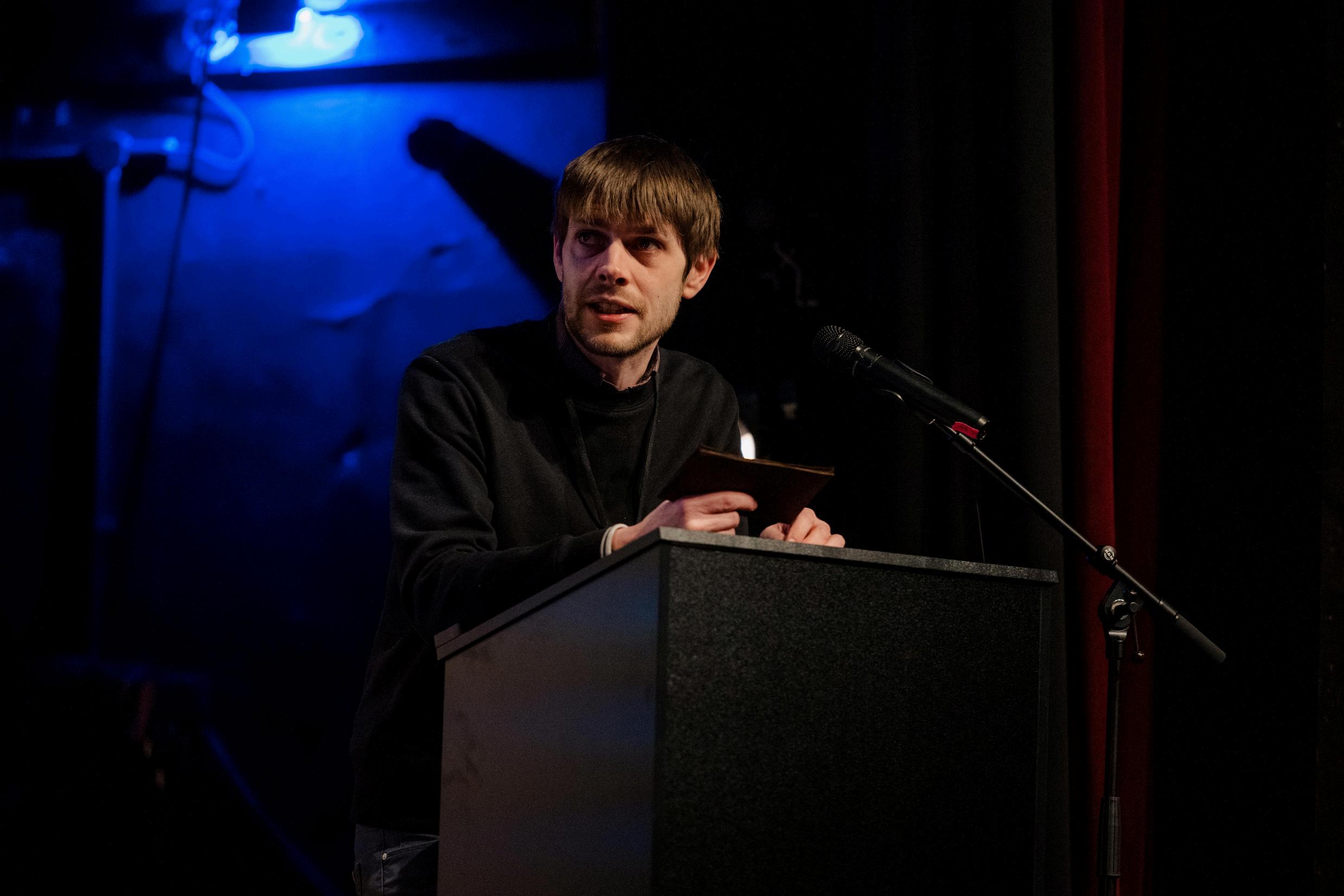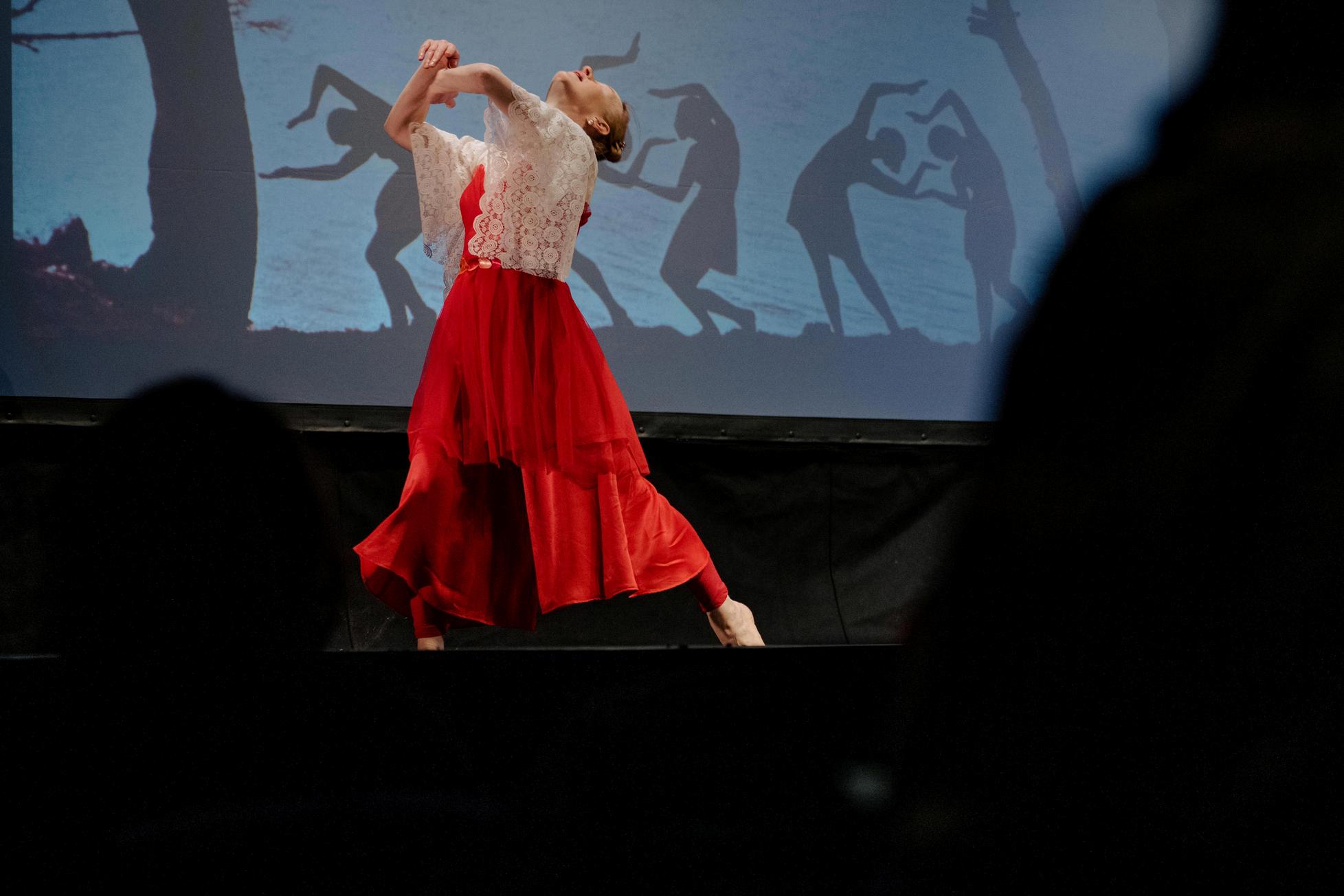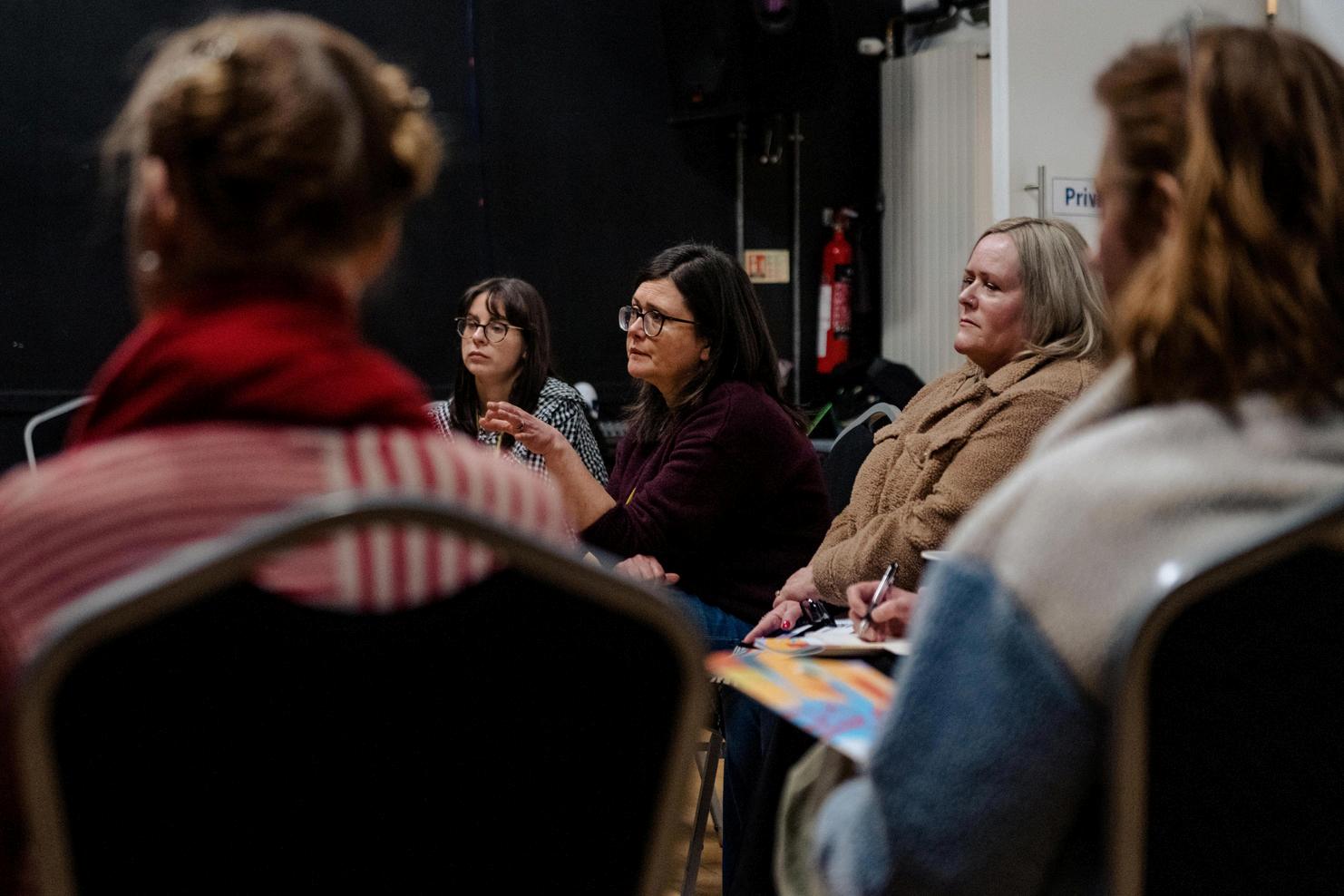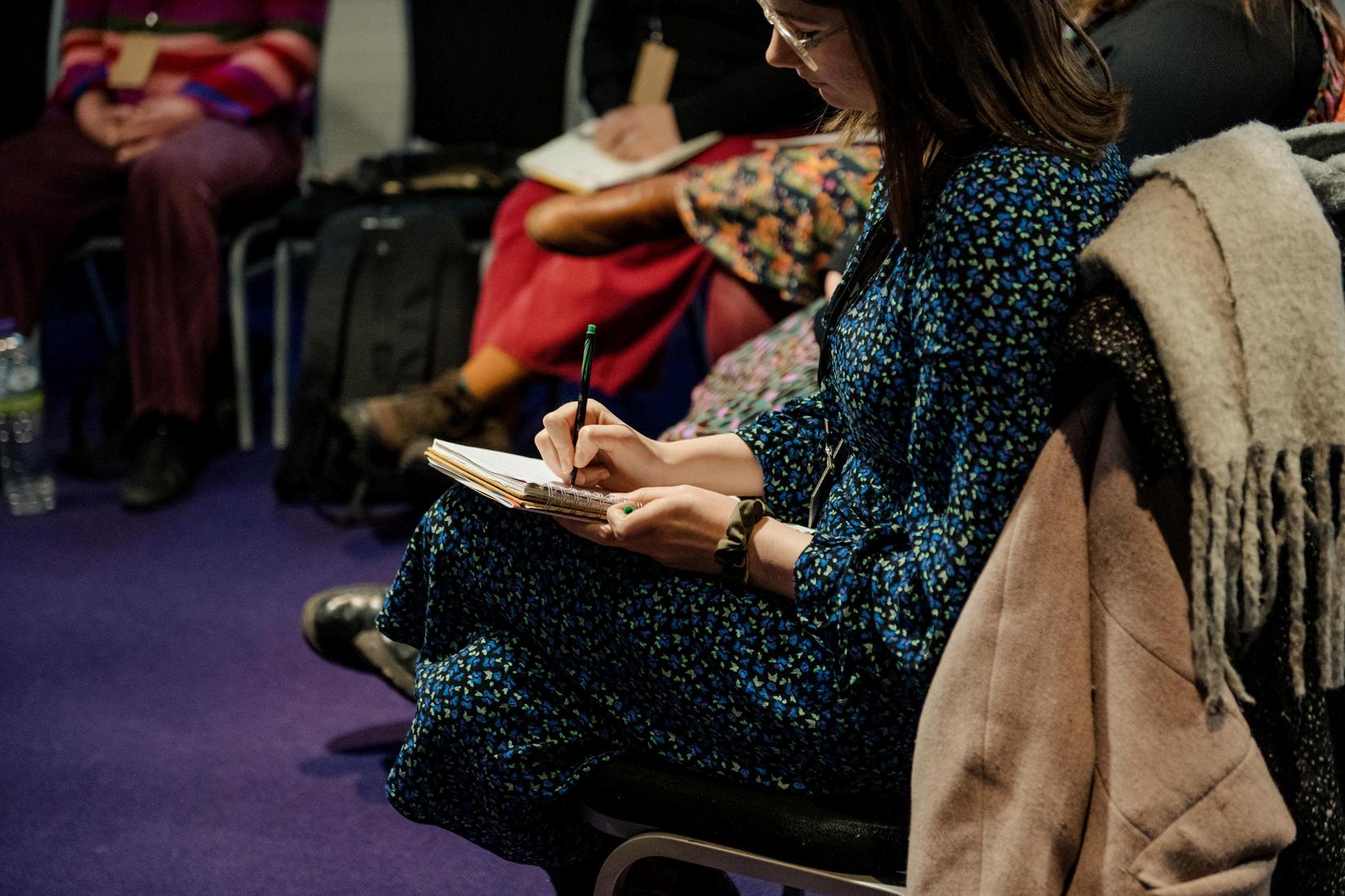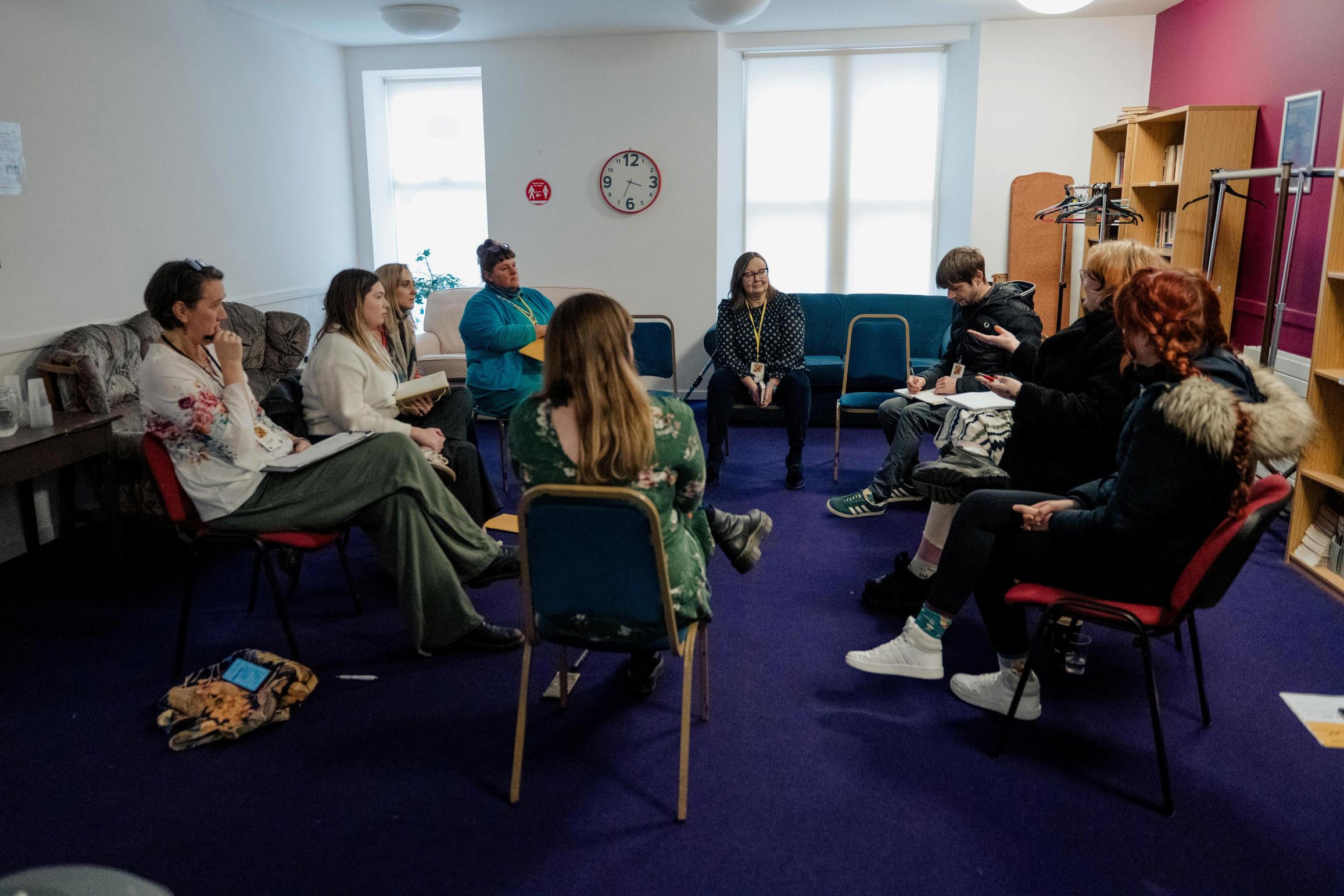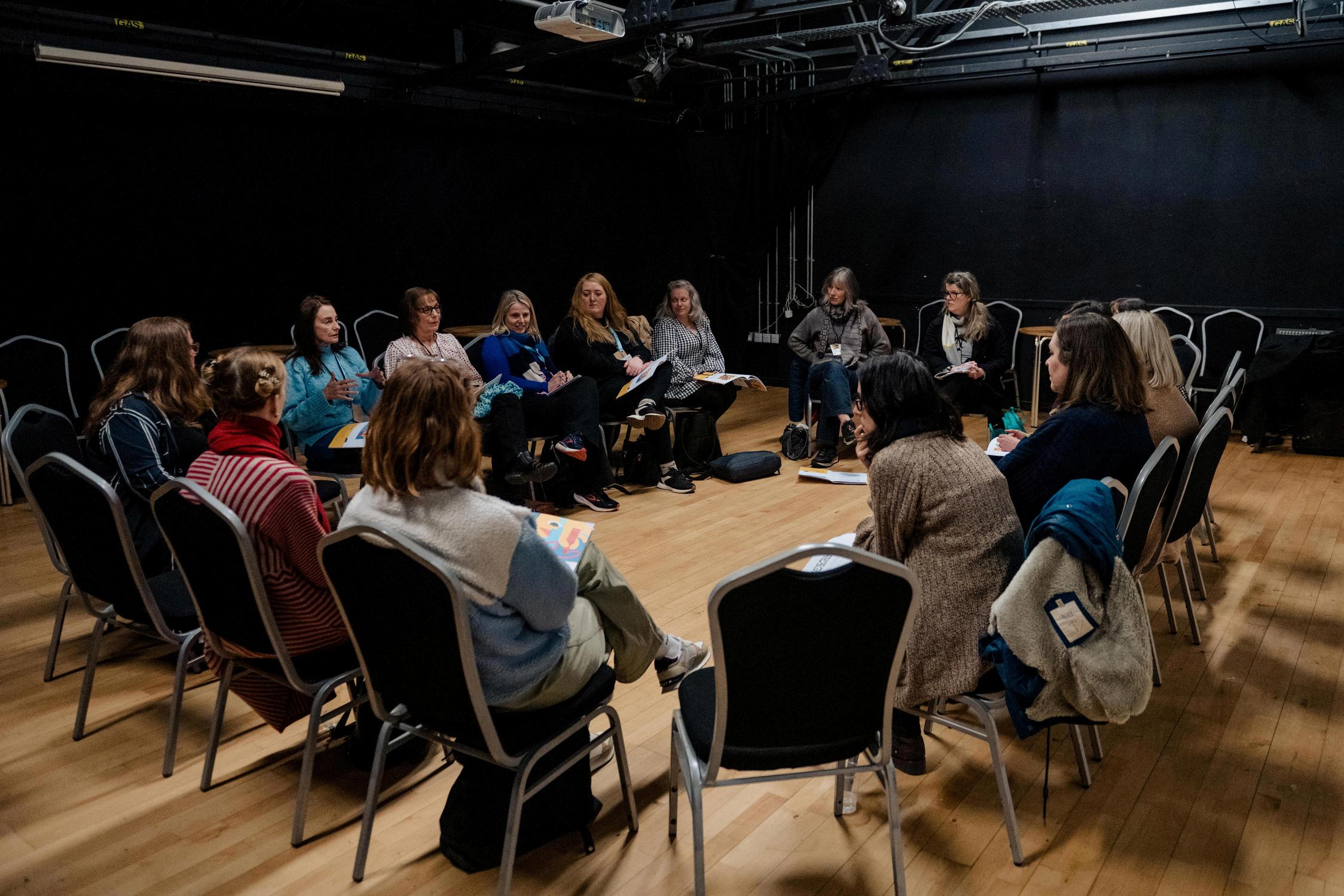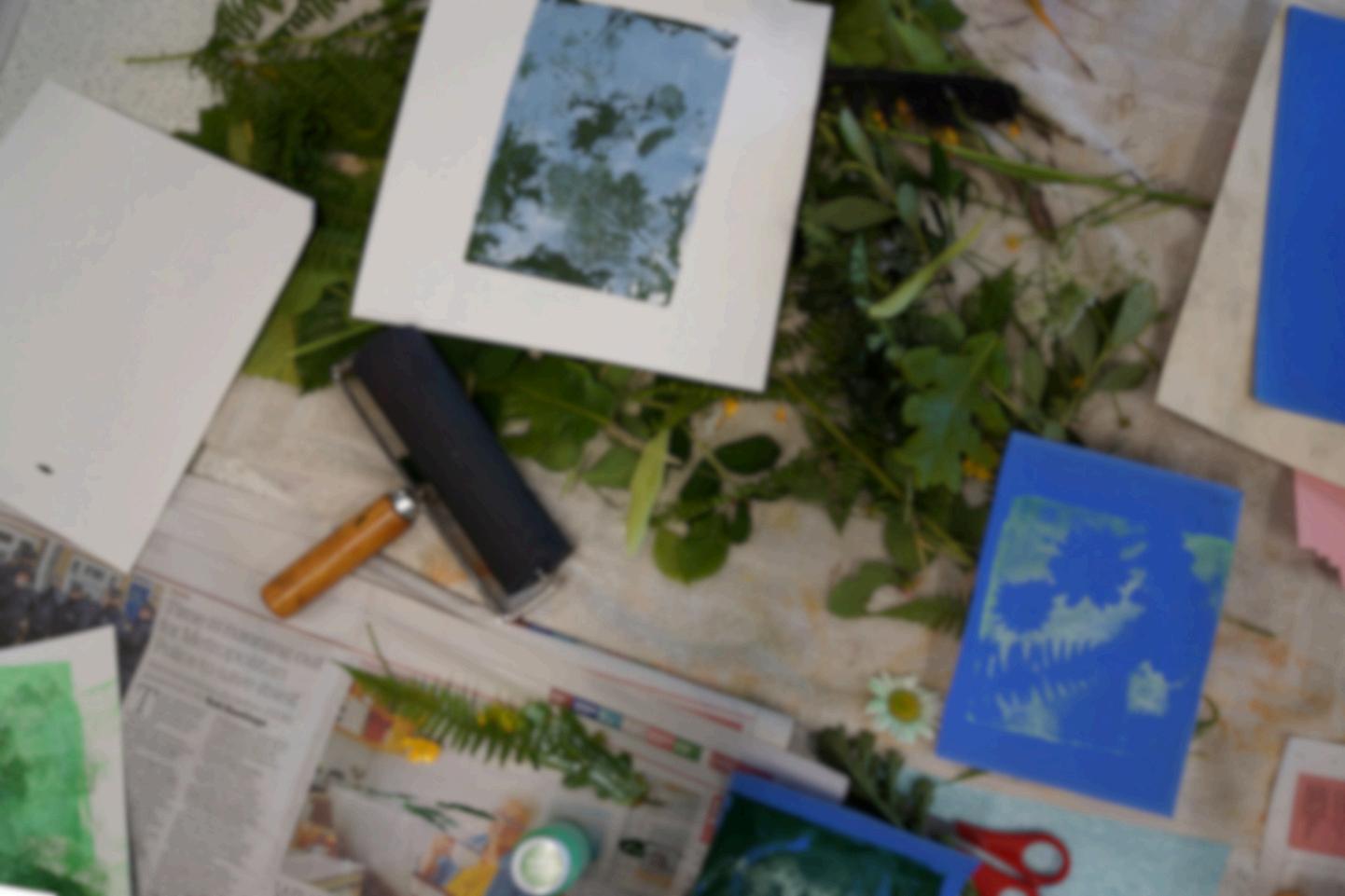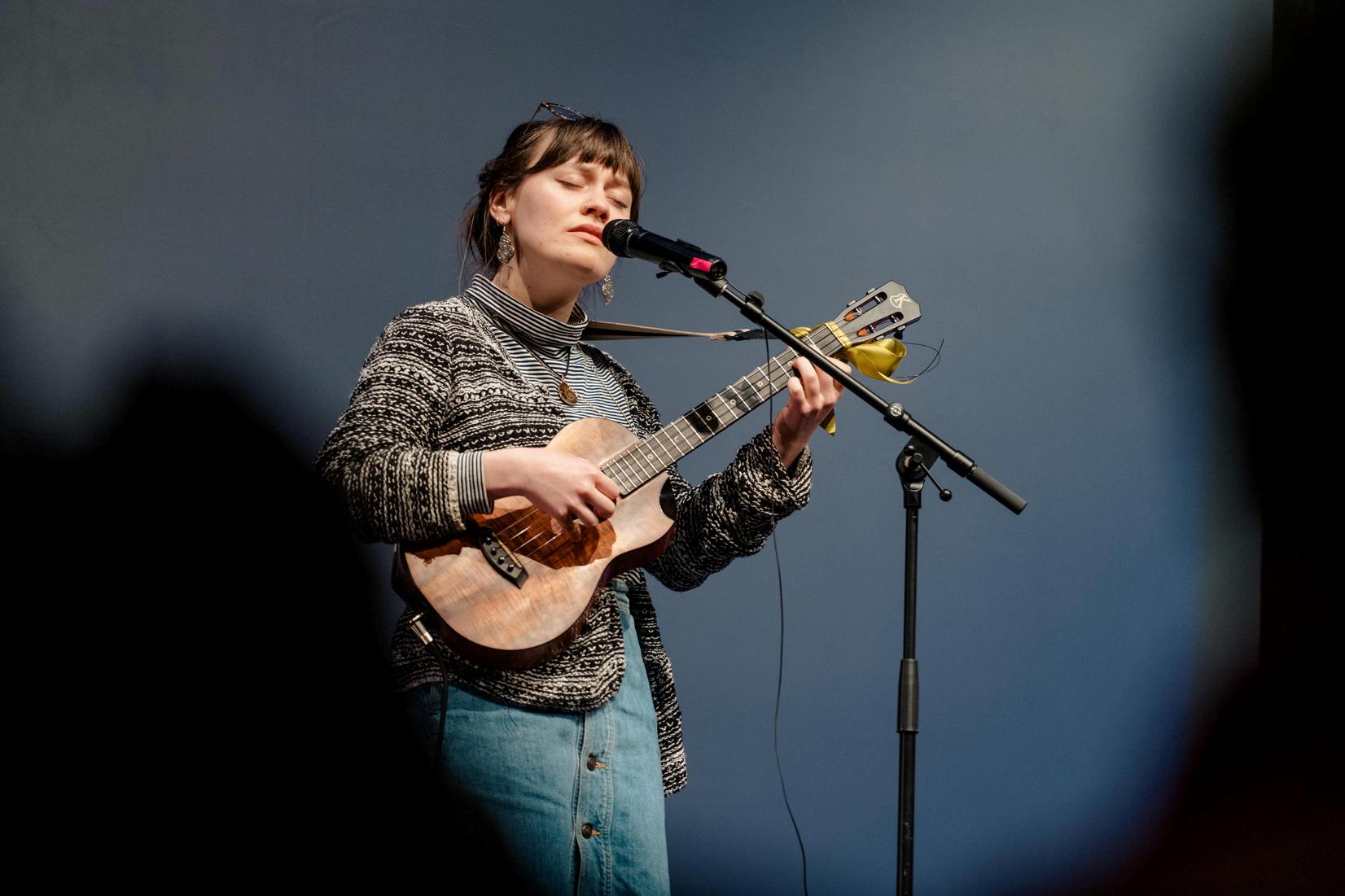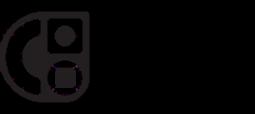Background:
In February 2025, OutPost Arts hosted a Creative Health & Wellbeing Symposium at the Theatre Royal, Dumfries – it was the first of its kind in our region and a significant marker for the progress that has been made to increase connections between the arts, culture, health and care sectors following on from the Covid-19 pandemic. From inspiring speakers to two breath-taking performances, the day was filled with thought-provoking discussions, creativity and a shared passion for the power of the arts in health and wellbeing. The symposium served as both a celebration of progress and a call to action—highlighting the incredible work already happening and the steps needed to sustain and grow creative wellbeing initiatives at local and national levels.
The aim of the Symposium was to:
➡ AMPLIFY regional creative health and wellbeing initiatives
➡ SPOTLIGHT examples of good practise
➡ CONNECT local, regional and national stakeholders’
➡ EXPLORE opportunities to embed work, increase investment and enhance learning
➡ SHARE research, strategies, knowledge and testimonies that underline art and culture’s connection to health and wellbeing
Attendees:
The symposium brought together a broad mix of professionals and practitioners across multiple sectors, reflecting the wide-reaching impact of creative wellbeing.
Attendees included -
Health & Social Care – NHS, public health and social work professionals, and professionals working in mental health, addiction support, and community wellbeing.
Arts & Culture – Artists, musicians, performers, creative producers, and cultural strategists - many involved in socially engaged arts and community-led initiatives.
Public Sector & Governance – Representatives from government, local authorities, and regional partnerships, reflecting policy-level interest.
Third Sector & Community Work – Charity leaders and grassroots organisers focused on inclusion, youth arts, and community-building.
Academia & Research – Researchers and academics exploring creative health and wellbeing through policy, rights-based, and/or community engagement lenses.
Key
Areas of Interest:
Expanding Knowledge & Understanding
Learn about creative wellbeing initiatives locally and nationally
Understand the role of arts in health, social care, and community settings
Explore new research and emerging strategies
Networking & Collaboration
Connect with professionals across sectors
Exchange ideas and experiences
Build partnerships in Dumfries & Galloway and beyond
Explore intersections with health, social care, education, and policy
Practical Application
Discover how creative wellbeing is being applied in real-world settings
Explore how to embed creativity in existing work
Community & Social Engagement
Support community-led initiatives
Foster social connection and reduce loneliness
Integrate creativity into everyday life and social prescribing
Supporting Specific Groups - Focus areas included:
Neurodivergent individuals
Mental health challenges
People living with dementia
Young people
Social care staff
Early intervention & prevention
Remarks:
To open our Creative Health & Wellbeing Symposium, we were thrilled to welcome four remarkable women from the arts and health sectors to deliver opening remarks:
➡ Lucy Bell - Creative Health & Wellbeing Director of OutPost Arts, launching A Manifesto for Creative Wellbeing in Dumfries & Galloway;
➡ Valerie White - Director of Public Health D&G, providing an overview of Regional Art in Healthcare;
➡ Marion Bain - Interim Deputy Chief Medical Officer for the Scottish Government, providing an overview of the Government’s aims and ambitions;
➡ Katharine Wheeler - Chair of the new regional Cultural Partnership, providing an overview of the partnership’s, aims and ambitions.
“I became involved with the regional Arts in Healthcare Steering Group in January 2024 and spent time last year seeing the outputs of the programme in action. Seeing the artwork and hearing stories of the participants were quite simply some of the highlights of my year. These programmes are the outcome of collaboration and are not overly directed by the NHS and the outcomes for people and our healthcare environment have been amazing.” - Valerie White
From left: Valerie White, Lucy Bell & Marion Bain launch the event with their opening remarks
Creative Wellbeing Manifesto:
During her opening remark, Lucy Bell, Director of DG Creative Wellbeing, unveiled the Creative Wellbeing Manifesto - a bold declaration of values that places creativity at the centre of health, education and community life.
The Manifesto lays out a clear set of principles that advocate for creativity as a fundamental part of living well - supporting not only recovery, but also connection, expression, and resilience. It also prompts an important conversation: how do we move from principles into practice?
Participants highlighted three key next steps:
Concrete implementation strategies to embed the Manifesto’s values into real-world contexts.
Sustained investment in creative health initiatives to ensure longevity and impact.
Future events and initiatives that provide case studies, practical tools, and collaborative spaces for cross-sector action.
The Manifesto was recognised as a powerful advocacy tool that has the potential to shape policy, influence practice, and inspire new approaches to wellbeing, but its success depends on collective commitment and long-term investment and support.
Keynote Speakers:
We had the privilege of welcoming three keynote speakers who captivated us with their knowledge, stories and forward-thinking ideas. Each brought a distinct perspective, shedding light on key challenges and opportunities in the creative health and wellbeing field.
➡ Nancy Riach, Director of Arts Culture Health and Wellbeing Scotland (ACHWS) - a national network supporting those working at the intersection of arts, culture, health, and wellbeing.
➡ Chris Fremantle, Producer specialising in public art, founder of ecoartscotland, Lecturer & Research Fellow at Gray’s School of Art, Robert Gordon University.
➡ Vicky Inam Mohieddeen, Creative Wellbeing Practitioner and Consultant with 20 years of experience working with communities worldwide. Vicky is a registered Drama Therapist.
Left: Nancy Riach
Right: Vicky Inam Mohieddeen
Chris Fremantle delivering his keynote presentation, sharing insights into his work
Spotlight Presentations:
We also hosted a series of ‘Spotlight’ presentations throughout the day to showcase inspiring initiatives happening around the region:
➡ Charlotte Riley Gibson, the D&G director of Paragon Music shared inclusive arts initiatives in Dumfries & Galloway. She was joined by Sarah Turner, a Paragon volunteer and musician who shared the positive impact Paragon has had on her life.
➡ Callum Morrison, A PhD researcher, presented his participatory research with OutPost Arts’ Creative Toolbox participants, exploring how young people become co-producers of the third-sector services they access, leading to positive outcomes for both the young people and the service.
➡ DG Creative Wellbeing Team shared highlights from their 2 year project across art in healthcare, network and community strands.
Charlotte Paragon Music’s Charlotte Riley Gibson (left) and Youth Lead Georgia Ireland (right) from OutPost Arts.
Callum Morrison presents his compelling research work focused on youth co-production in community projects.
Local dance artist Sara Shackleton introduced attendees to the Margaret Morris Movement via an expressive performance before leading the audience in a guided breathing exercise.
Our Creative Wellbeing Symposium was filled with moments that inspired, connected, and moved us. Here are some of the standout highlights shared by attendees:
Event Highlights: Celebrating Cross-Sector Work
Forming Connections, Sharing ideas & Learning from Others Shared Passion & Momentum
The Breadth & Depth of the Work Showcased
Powerful Performances & Presentations
Breakout Sessions:
In the afternoon, everyone had the chance to attend a breakout room of their choice to discuss themes from the Creative Wellbeing Manifesto in practice, from varying perspectives.
Breakout Session > Art in Healthcare
The group focused ‘Creative Wellbeing is about Living Well’ and ‘Creative Wellbeing needs Investigation, Understanding & Investment’.
Discussion centred around the role of creativity from pre-natal to end-of-life care, exploring how art can help connect palliative patients and their loved ones to meaningful forms of expression. A key point of distinction was made between art therapy and creative wellbeing, and the group acknowledged the incredible work already being done by Occupational Therapy teams, highlighting Midpark, where creativity is used to support recovery and promote self-care. Artist-led initiatives, which typically take a less direct approach than arts therapy, were highlighted as valuable for fostering group engagement and enhancing wellbeing for both patients and staff.
The group agreed that initiatives like DG Creative Wellbeing have the potential to complement and amplify existing services, reaching broader audiences and showcasing the profound benefits of creative activities.
The need to improve communication around creativity was raised - ensuring people understand that creativity is for everyone, not just artists. This includes recognising everyday creative pursuits as valuable tools for managing stress, anxiety, and depression, especially from an early age, to build resilience. Challenges were identified, including limited financial support and the need to overcome stigma around art. Clear, accessible communication about the health benefits of creativity was seen as essential to embed art inclusively.
Breakout Session > Creativity in Young People
Discussions centred around ‘Art is a Vehicle for Change’ and ‘We are All Artists’.
Attendees reflected on the challenges young people face when trying to access creativity within a highly structured and outcome-driven school system, which often lacks space for self-expression and trust. There was concern that negative experiences in school can discourage further engagement, particularly when creative subjects are deprioritised or less accessible due to funding or staff shortages.
The group explored how community-embedded organisations like Paragon can play a vital role in offering creative opportunities, within or outside of school settings, whilst also recognising the importance of respecting school routines and boundaries.
Emphasis was placed on creating safe, inclusive environments where young people - particularly those in deprived areas - feel empowered and heard. Building trust, using accessible and familiar language, and involving young people meaningfully - such as through truly responsive Youth Advisory Groups - were seen as essential to nurturing creativity and affirming that every young person is an artist with the power to make change. It was agreed that these groups only succeed when young people’s voices are genuinely listened to and incorporate into planning - when they can see their ideas being acted upon, it promotes feelings of trust and ‘buy-in’.
Breakout Session > Creative Wellbeing in Communities
Discussion centred around ‘Creative Wellbeing is for Everyone’ & ‘Creative Wellbeing is about the Journey, not the Destination’.
The group questioned what ‘for everyone’ really means… the importance of focusing on ‘equity over equality’ was emphasised, recognising that people face different barriers and starting points, requiring support that works for different needs rather than uniform approaches. The group discussed how marginalised groups can feel excluded from creative or wellbeing spaces. Whilst practical barriers such as resourcing and logistics play a role, participants identified that exclusion often stems from language, representation, and people simply not feeling like art isn’t "for them." Many organisations acknowledged struggling to reach men in their projects, reflecting on how their language around creativity and wellbeing might not connect with target audiences.
Participants shared practical strategies for increasing accessibility: codesigning with communities to root activities in people's actual lives and cultures; removing practical barriers through free transport, financial support, and childcare; using clear, plain language whilst avoiding jargon; and being mindful about cultural relevance and communication styles. The group also discussed broadening how we define creativity itself—recognising that it encompasses all art forms including writing, theatre, performance & broadcasting, handicrafts and making, and everyday creative practices such as gardening and cooking, not just traditional visual arts.
(Communities continued)
DG Creative Wellbeing shared examples from their community-based projects, namely Art Journal Project and Creative Toolbox, where they offer free transport to sessions for those that need it and provide art materials, so that all participants have the same resources in order to take part.
Organisations like Catherine Street Inclusive Park have found success attracting older men and fathers through task-based volunteer activities like building planters, which provide familiar entry points and pathways toward creative engagement.
The discussion around "journey not destination" emphasised that creative wellbeing isn't about ticking boxes or reaching specific outcomes, but creating space for people to express themselves, connect, socialise and grow in meaningful ways. Interestingly, the group heard from organisations that don't specifically identify as creative wellbeing projects but inadvertently offer the same benefits - connection, community, and expression - through their social activities, such as those offered by Dumfries Get Together.
Funding challenges emerged as a persistent barrier, with groups struggling to secure funding for core roles and rental of permanent spaces despite demonstrating community need. The session highlighted the tension between universal "for everyone" programming and the necessity of targeted approaches, concluding that meaningful inclusion often requires strategies tailored to suit different communities' needs and preferences rather than a one-size-fits-all solution.
Feedback & Reflections:
What Worked Well?
Attendees appreciated the diverse range of speakers, offering a strong mix of strategic insights and project-based content.
Presentations effectively showcased:
➡ The breadth of creative wellbeing initiatives across D&G
➡ The role of creativity in health and social care
➡ Cross-sector collaboration strategies
➡ Opportunities to embed creative wellbeing in national policy
Breakout sessions provided valuable networking, allowing attendees to:
➡ Connect across sectors
➡ Exchange ideas and share personal experiences
➡ Identify opportunities for future collaboration
What Could Be Improved?
A day packed with presentations led to -
Limited time for informal discussion or reflection
A largely passive format, with little interactivity
Breakout sessions suffered from -
Being too short and lacking structure
Reduced participation due to overrun presentations
At the end of the day...
Attendees reported feeling:
➡ Reinvigorated in their work
➡ Inspired by shared experiences
➡ Excited by opportunities for collaboration
The event deepened understanding of creative wellbeing, revealing:
The breadth of work taking place across policy, research, and community practice
The value of the Creative Wellbeing Manifesto
The potential of arts integration in healthcare
Strength in local partnerships
A renewed sense of pride in Dumfries & Galloway’s creative, third sector and health sectors
What’s next for Creative Health and Wellbeing?
Turn principles into practice
More space for collaboration and learning
Build knowledge and confidence
Keep the conversation going
“Fantastic to hear first hand from everyone and learn more about the wider value of creative wellbeing... Each person brought something really important to the 'stage' making for an interesting and thought provoking day.”
“It made me think about my own organisation and how we can think more creatively around health and wellbeing”
“It gave me a lot of different ideas to take back to my organisation. It renewed my enthusiasm.”
Presentations & Breakout Sessions: Next Time
Looking Ahead: A Two-Day Event?
With so much to discuss and learn from, a longer format could enhance the experience:
➡ More interactive sessions + in-depth Q&As between presentations
➡ Parallel sessions to suit varied interests
➡ More time for networking and collaboration
What We’d Do Differently:
Schedule breakout sessions earlier in the day
Strengthen breakout facilitation for more focused dialogue
Offer more breathing space between presentations for informal networking and reflection
Reduce the number of speakers or spread the programme over two days, to avoid too many presentations in one day
In Conclusion:
The event had a significant impact on attendees’ understanding of creative wellbeing. It illuminated the breadth of work happening across the region and beyond, from policy and artistic research to communitybased practice, and brought to the forefront the strength of partnerships and the collaborative pathways being forged.
For some, the symposium deepened their awareness of how creative wellbeing connects with their own work. Others found it a valuable space to learn about different approaches including the role of the Creative Wellbeing Manifesto and the growing integration of arts into healthcare settings. These exchanges sparked fresh thinking, new energy, and practical ideas that attendees were keen to carry forward into their own organisations.
There was a strong sense of pride in the work being done across Dumfries & Galloway, particularly in the creative and health sectors. At the same time, some participants highlighted the importance of translating discussion into action - calling for tangible implementation and long-term support.
Overall, the event successfully raised awareness, encouraged crosssector collaboration and reinforced the vital role creative wellbeing plays in shaping healthier, more connected communities.
Local Singer & Songwriter Zoe Bestel performed two original songs connected to the wellbeing theme.
Thanks to:
Our event funder: Regional Culture Fund
Speakers: Valerie White, Professor Marion Bain, Katherine Wheeler, Nancy Riach, Charlotte Riley Gibson, Sarah Turner, Callum Morrison, Vicky Inam Mohieddeen, Chris Fremantle
Performers: Sara Shackleton, Zoe Bestel
Volunteers: Hilary Coombs, Heather Bestel, Karen Solly, Martha Schofield, Jacqueline Buckham
OPA Team: Georgia Blue Ireland (Event Producer), Lucy Bell, Diane Hay, Phoebe
Watt, Kirstin McEwan, Liz McQueen, Alison Hotchkiss
OPA Board: Euan MacLeod, Suzie Thorpe, Jason Railton, Carys Mainprize, Jackie Zhender, Peter Sabuldihin
Photography: Kirstin McEwan
Videography: John Wallace for Regional Cultural Fund, Ruari Barber-Fleming for OutPost Arts, supported by Arts Culture Health Wellbeing Scotland
BSL Interpreter: Andy Long
Catering: The Usual Place
Venue: Theatre Royal, Dumfries
